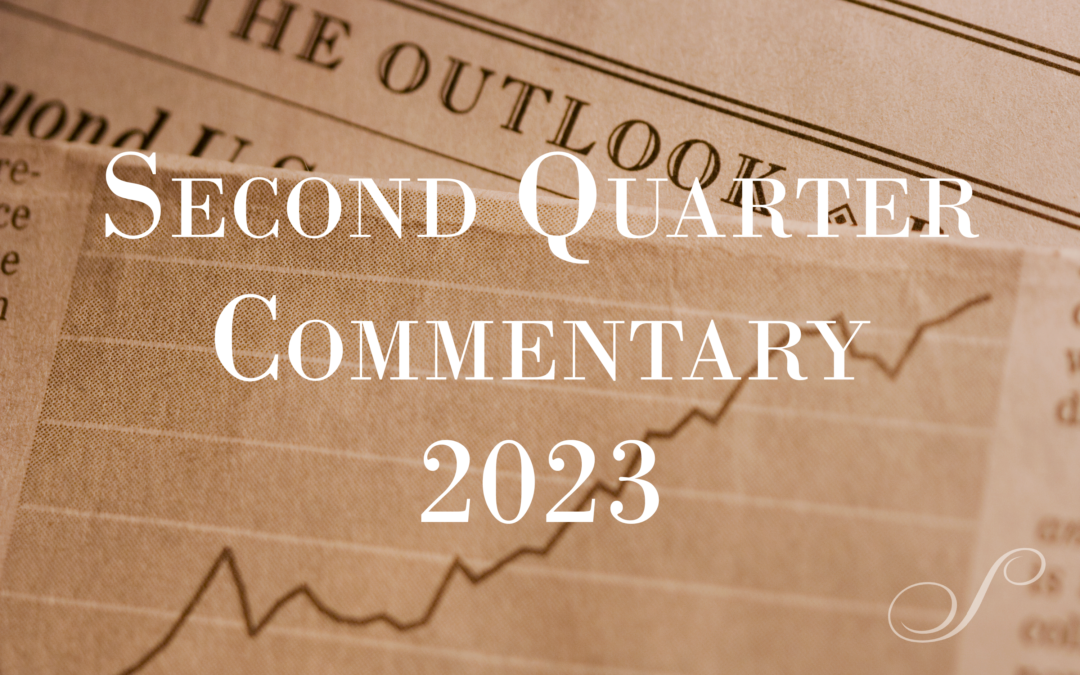The economy and the markets proved to be more resilient than nearly everyone anticipated in the second quarter. The economic data has been surprising to the upside with the Citi Economic Surprise index nearing the highs of its historical range. While we still expect the economy to slow, the chances of a recession this year appear to have diminished. The labor market continues to balance itself with wage growth decelerating and unemployment remaining low. The “mini” banking crisis that occurred in March seems to have been contained although lending standards have tightened, and commercial real estate loans remain a risk to regional banks. The Artificial Intelligence (AI) frenzy buoyed technology stocks, which led the stock market higher. In June, the Federal Reserve (FED) chose not to raise the Fed Funds Rate for the first time since early 2022, but included a hawkish statement in which they left the door open for two more rate hikes this year. While the fundamental economic data has improved, so to have the equity markets, leaving them at risk should a more severe economic downturn or exogenous shock occur.
Consumer sentiment bottomed in June 2022 at a level below what we saw during the Great Financial Crisis. We looked at the average annual returns on the S&P 500 after sentiment peaked and troughed going back to 1970. The results are summarized in the table below, but the underlying conclusion is that equity returns are better when sentiment is worse.
If we look at the misery index, which is a measure of economic distress felt by everyday people and is calculated as the sum of the unemployment rate and the inflation rate, it is at 6.6 for June. This is better than 83% of the time in the last 45 years. The latest University of Michigan Consumer Sentiment report came in at 64.4. This is lower than it’s been 92% of the time over the last 45 years. That gap between the misery index (how the data says people are) versus sentiment (how people feel) is nearly as large as we’ve ever seen. This illustrates the disconnect between perception and reality. Often times when sentiment is so much worse than what the macro-economic data suggests, that leaves room for opportunity.
The US economy likely grew in the second quarter with the Atlanta FED GDPNow forecast at 2.3%. This would mean the economy grew 2.5% year-over-year, which is above the 2% trend growth. The cyclical sectors of the economy are near their long-term averages and not over extended. Housing seems to have found a bottom and one of the contributing factors is that in April about 1/3rd of all home purchases were cash offers. Light vehicle sales have also begun to pick up after some weakness the last few years. Much recent consumer spending has come from wealthier households, and because of the recovery in the markets we’ve seen a $6.5 trillion increase in net worth in the first half of the year. The strong labor market is also supportive of the economy. While job openings are coming down from their March 2022 peak, they are coming down slowly with 9.8 million jobs openings in May. If they continue to fall at the current pace, job openings won’t return to their pre-Covid highs until the end of 2024. Nonfarm payrolls increased 209,000 in June, while the unemployment rate ticked down to 3.6% and wage growth moderated. The labor market is normalizing, but it is at a slow pace, and a strong labor market is supportive of income and therefore consumer spending which drives the economy.
Inflation peaked in June 2022 and has been falling since, with June CPI coming in at 3%. Shelter makes up 1/3rd of the CPI index and due to its lagged effect, it is still contributing 2.5% to the headline number. Transportation services (ex-airfare) account for about 2/3rd of core services ex-shelter inflation. This is mainly auto repair and insurance that shot up along with auto prices but is now beginning to roll over. Perhaps more important was core CPI rose only 4.8% or .2% less than expected. Core CPI tends to be stickier and lags the change in CPI. Inflation tends to rise rapidly and then fall rapidly and we are now seeing it fall at roughly the same pace it rose. There are, however, some structural headwinds challenging the FED and its 2% target. The beginning of deglobalization in the aftermath of Covid, the transition to cleaner energy sources and less immigration should all put upward pressure on prices. Some may be offset by increased productivity, perhaps using AI, but nevertheless there is the possibility of higher prices and therefore higher interest rates in this next cycle than in the last.
While the economy and the markets did well in the first half of the year, there are still risks ahead. The FED engaged in one of its most aggressive rate hiking campaigns in history. It is known that monetary policy has a lagged and variable effect so the full effect of their rate hikes may yet to be seen. An inverted yield curve has historically been a reliable indicator for an upcoming recession. However, the FED said rather explicitly they were going to raise rates and then cut them, so perhaps the prospect of lower interest rates in the future has made this a less reliable indicator.
One of the big unknowns is how the regional banking sector will handle declining deposits, the recent stress in the commercial real estate market and what this may mean for lending. Deposits have been leaving the banking sector since rates began to rise as people and institutions search for higher yields in CD’s and money market funds, rather than low yielding bank accounts. The “mini” banking crisis only accelerated this trend. Regional banks account for 75% of lending for commercial real estate. Commercial real estate, specifically office and retail, is an area of risk. Commercial real estate is typically financed with a 30-year loan with an interest rate that resets every three years. When these rates reset to significantly higher levels at a time when occupancy rates, particularly in major cities, have plummeted, these loans become at risk of default. Luckily, office only makes up 15% of the commercial real estate sector and other areas such as manufacturing, industrial, and warehousing continue to shine.
The stock market rallied in the first half of the year, led primarily by mega-cap growth stocks. While this narrow leadership can be a cause of concern, over the past month the rally began to broaden out with the S&P 500 equal weight index outperforming the S&P 500 (market cap weighted) index. As interest rates rose, we did add a core bond position on the low-risk side of the portfolio. While we remain underweight duration (interest rate risk) when the yield on the 10-year treasury moved above 3.8%, we felt it was prudent to begin adding some back to the portfolio.
In conclusion, the second quarter built on the strength of the first. The fundamental economic data generally beat expectations, stocks appreciated, inflation continued to cool, and the FED paused its rate hikes at the June meeting. While there is still uncertainty, the economy may not be as grim as sentiment would indicate. Stocks are more expensive than they were to start the year, but the stock market is forward-looking and perhaps it sees better days ahead. We hope you like the look of your new quarterly report and can understand the information displayed.
Certainly, reach out to me (Michael) or your advisor with any specific questions you may have.
All our best,
The Management Team
Michael, Michelle, Jolie and Nina
Important Disclosure Information
Please remember that past performance may not be indicative of future results. Different types of investments involve varying degrees of risk, and there can be no assurance that the future performance of any specific investment, investment strategy, or product (including the investments and/or investment strategies recommended or undertaken by Socha Financial Group, LLC (“SFG”), or any non-investment related content, made reference to directly or indirectly in this commentary will be profitable, equal any corresponding indicated historical performance level(s), be suitable for your portfolio or individual situation, or prove successful. Due to various factors, including changing market conditions and/or applicable laws, the content may no longer be reflective of current opinions or positions. Moreover, you should not assume that any discussion or information contained in this commentary serves as the receipt of, or as a substitute for, personalized investment advice from Socha. Please remember to contact Socha, in writing, if there are any changes in your personal/financial situation or investment objectives for the purpose of reviewing/evaluating/revising our previous recommendations and/or services, or if you would like to impose, add, or to modify any reasonable restrictions to our investment advisory services. Socha is neither a law firm, nor a certified public accounting firm, and no portion of the commentary content should be construed as legal or accounting advice. A copy of the SFG’s current written disclosure Brochure discussing our advisory services and fees continues to remain available upon request.
Historical performance results for investment indices, benchmarks, and/or categories have been provided for general informational/comparison purposes only, and generally do not reflect the deduction of transaction and/or custodial charges, the deduction of an investment management fee, nor the impact of taxes, the incurrence of which would have the effect of decreasing historical performance results. It should not be assumed that your Socha account holdings correspond directly to any comparative indices or categories. Please Also Note: (1) performance results do not reflect the impact of taxes; (2) comparative benchmarks/indices may be more or less volatile than your Socha accounts; and (3) a description of each comparative benchmark/index is available upon request.
Please Note: Limitations: Neither rankings and/or recognition by unaffiliated rating services, publications, media, or other organizations, nor the achievement of any designation or certification, should be construed by a client or prospective client as a guarantee that he/she will experience a certain level of results if Socha is engaged, or continues to be engaged, to provide investment advisory services. Rankings published by magazines, and others, generally base their selections exclusively on information prepared and/or submitted by the recognized adviser. Rankings are generally limited to participating advisers (see link as to participation data/criteria, to the extent applicable). Unless expressly indicated to the contrary, Socha did not pay a fee to be included on any such ranking. No ranking or recognition should be construed as a current or past endorsement of Socha by any of its clients. ANY QUESTIONS: SFG’s Chief Compliance Officer remains available to address any questions regarding rankings and/or recognitions, including the criteria used for any reflected ranking.

